 |
||
|
||
| ||
Serial ATA interface is not just a convenient replacement for the good old parallel UltraATA (IDE) in desktop computers. A noticeable share of Serial ATA devices is intended for professional use. It should even force out some other more expensive interfaces from the market of entry-level professional storage devices. It's favored both by higher performance of SATA versus PATA as well as by its expanded functionality, which gets close to SCSI features to some degree. Among other things, a very useful feature is the hot-swap function of storage drives, initially built into the SATA interface. In this connection, Adaptec, Inc, a distinguished manufacturer of controllers and data storage systems, made a natural step at the end of 2004 - it launched a kit consisting of the middle-end four-port SATA RAID controller AAR-2410SA (which had appeared on the market before this kit) and a enclosure for four SATA hard disks. This system (with RAID 5 and hot swap support) is called Adaptec Serial ATA RAID 2410SA Enclosure Kit. In this article we are going to review its main features. 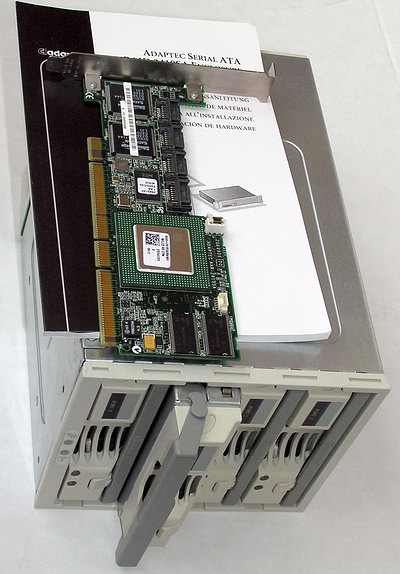 The bundle is simple: aside from the enclosure for 4 x SATA drives and a slightly updated AAR-2410SA controller  there are 4 one-meter SATA cables, a low-profile bracket for a controller (it allows to install it into a low-profile PC cases with connected SATA cables), two bulky manuals in various languages (one about the controller, the other about the kit), and a CD with drivers and utilities. The bundle also includes a special 4-wire cable to connect the enclosure to the controller (running order indicators on the front panel of the enclosure):  The enclosure comes in two colors — beige (on the photo) and black. The manufacturer offers three-year warranty for this kit.
Design and SpecificationsThe kit is based on the Singapore-manufactured  well-known low-profile four-port SATA RAID controller Adaptec AAR-2410SA for PCI 64bit/66 MHz bus (compatible with PCI 32 bit/33 MHz) supporting RAID 0, 1, 5, 10, and JBOD - presented by the manufacturer as an ideal solution for workstations and entry-level servers. 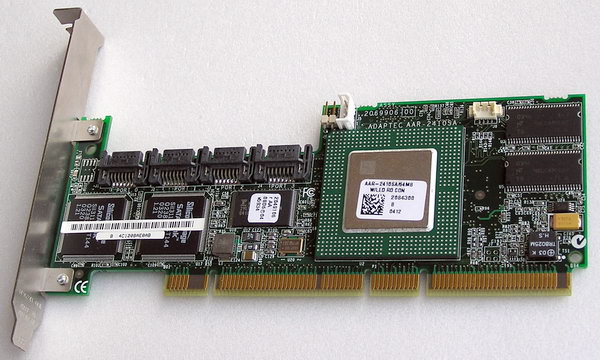 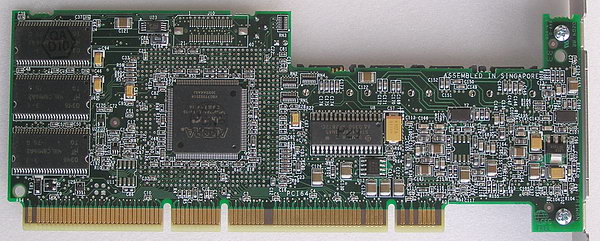 Adaptec Serial ATA RAID 2410SA controller for PCI64 bus.
It's a relatively old controller — it appeared together with the SATA interface. It's based on two practically the first (quite successful at that) dual-port SiI3112A SATA chips from Silicon Image with the interface transfer rate of 1.5 Gbit/s, 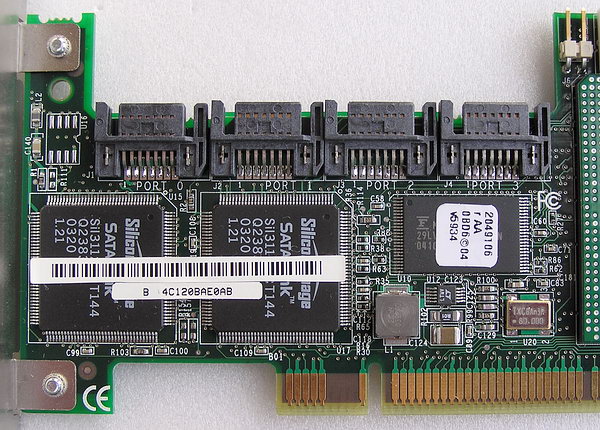 which were obviously selected because they had been initially designed as Serial ATA products (without the heavy heritage of UltraATA interface). They could work with 66 MHz PCI bus, they offered the best support for hot swapping, and possessed the best compatibility with various storage drives (preliminary and final tests of all storage drives must be based on SiI3112A). Intel GC80302 processor "combines" two dual-port SiI3112A controllers into a single four-port controller supporting RAID 5 and 10. Adaptec traditionally uses this processor in its products and has already fine-tuned universal Adaptec RAID code: 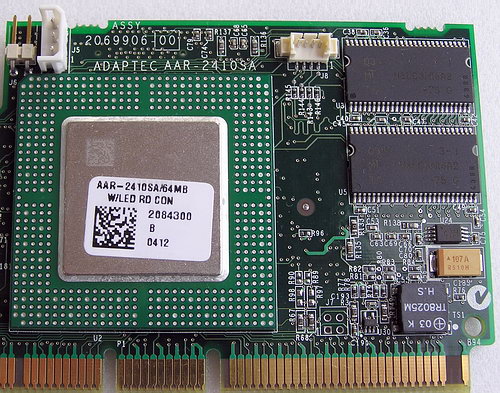 Besides, the AAR-2410SA controller carries 64 MB of rather fast (133 MHz) cache memory, 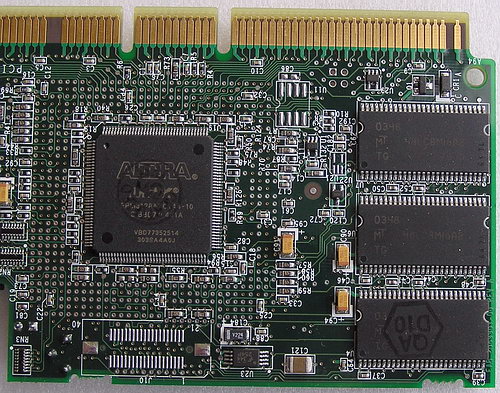 which characterizes this product as intended for professional systems. 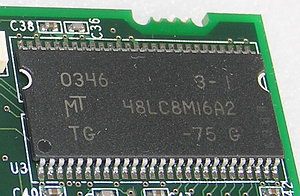 By the way, the price for this controller is also very high — up from $270 in Moscow retail just for a controller (without an enclosure, which doubles the price). Note that the simplest "consumer" dual-port SATA cards based on SiI3112A have already dropped to $15-$20. Perhaps, the main difference of the sole AAR-2410SA controller from the same controller in the 2410SA Enclosure Kit is a special 4-pin connector in the latter (on the photo on the right),  intended for plugging a signal cable from the enclosure, which controls LEDs on its front panel. The enclosure from the Adaptec 2410SA Enclosure Kit is a double-wall tin case occupying three 5¼" bays in a system unit  with four tin sleds for hard disks, 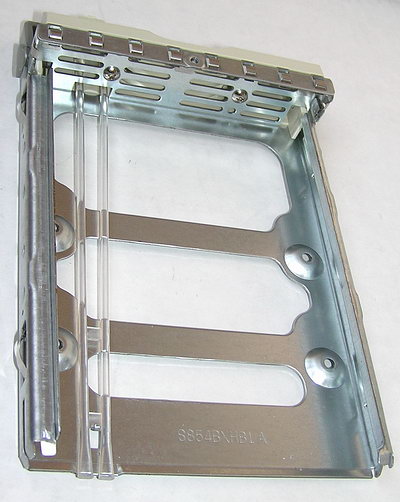 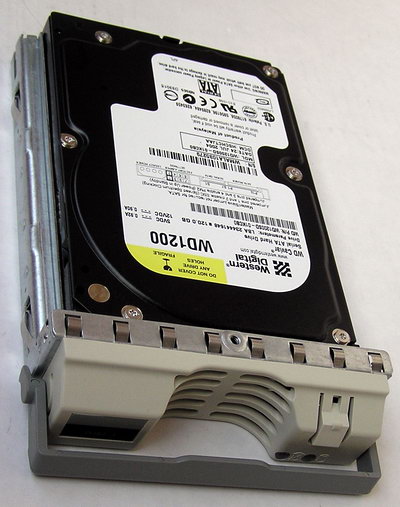 which are installed vertically in a tower PC case.  Each individual bay is equipped with a flap handle for removal and a latch (hard drives cannot be locked with a key). The sleds are numbered from Port 0 to Port 3 (that's why you should stick to this order, when you install hard disks into the enclosure). Each one is equipped with two LEDs (HDD activity and power).  The enclosure itself has two indicators at the side — fan mode and system overheating. Even though the enclosure proudly bears the Adaptec label, it evidently resembles the famous CSE-M34T from Supermicro, a title on the PCB inside the enclosure proves it: 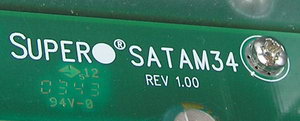 The enclosure is equipped with one 90 mm fan, blowing the air out.  Its rotational speed can be controlled automatically depending on the temperature inside the enclosure (there are special jumpers on the board for this purpose).  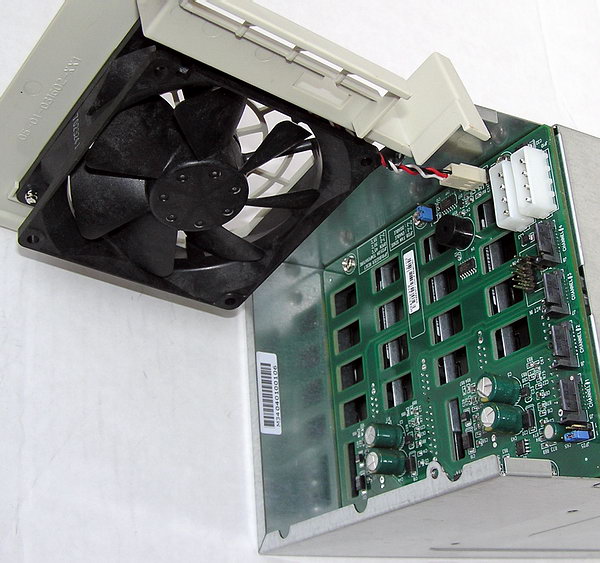 Serial ATA ports (channels) are numbered on the board. 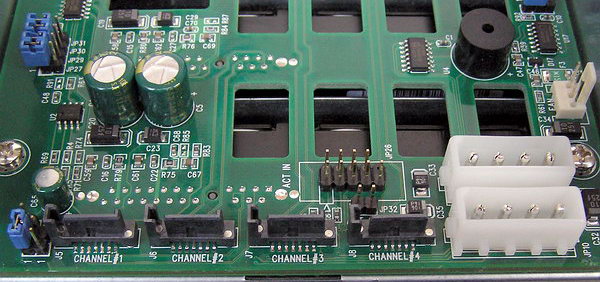 There are four SATA connectors with filtered power supply at the back of the enclosure board, 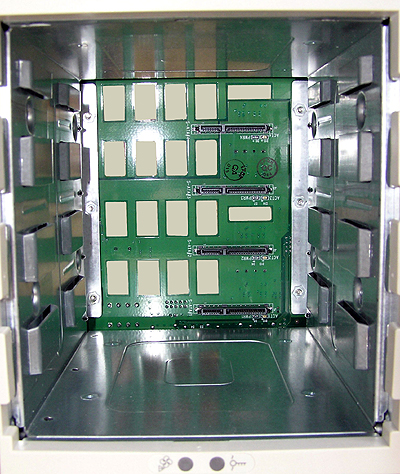  so that it's no problem to install and remove hard drives, even when the system is running. There are two unpackaged LEDs near each of these connectors (see the photo of a connector above). Their light is "delivered" to the front panel of the enclosure through plastic light pipes (they are laid on the sledge under a hard drive). 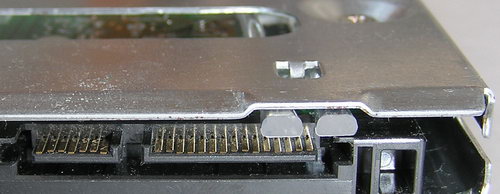 And finally, there is a special pin-connector at the back for a 4-wire cable to the AAR-2410SA controller. 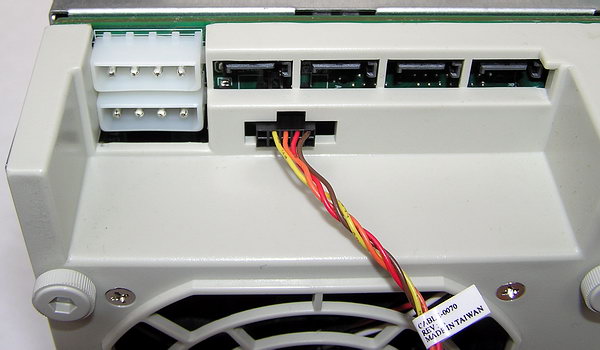 This cable is used by the controller to indicate a RAID failure with a blinking LED on the front panel of the enclosure (using special BIOS code). Here are Activity LEDs Pin Definitions (ACT IN, JP26), taken from Supermicro's CSE-M34 Mobile Rack User's Guide (unfortunately, Adaptec does not offer such documentation for its enclosure): 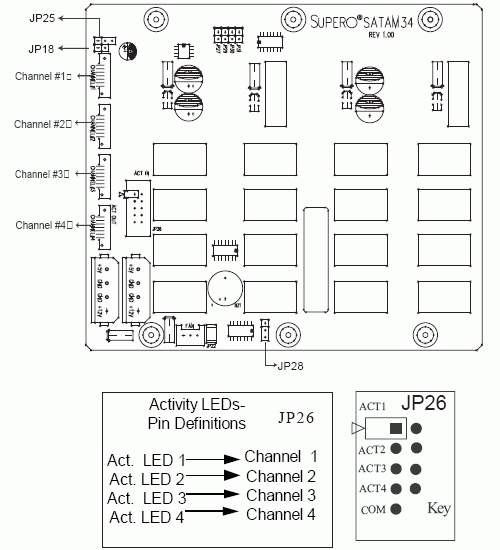 Adaptec 2410SA Enclosure Kit's specifications highlight the hot swap feature, online RAID update, advanced RAID features (for Levels 0, 1, 5, 10 and JBOD) inherited from Adaptec SCSI controllers, including OCE (Online Capacity Expansion), RLM (RAID Level Migration, e.g. from RAID 0 into 5 or 10, from RAID 1 into 0, 5 or 10, from RAID 5 into 0 or 10, from RAID 10 into 0 or 5), creating several arrays on a single RAID, and optimized disk utilization. The main control features like enclosure management, S.M.A.R.T. and SNMP are also supported. The list of operating systems supported includes Windows 2000/XP/Server2003, NetWare 6.0 and higher, RedHat Linux, SuSE Linux, SCO UnixWare, and Caldera Open Unix. Controller's BIOS contains a proprietary utility to monitor and configure operating parameters of the controller and connected drives. Lots of useful RAID management features are available under Windows thanks to Adaptec Storage Manager utility. Of course, there is no NCQ support, 3 Gbit/s, port multiplication, or sequential disk spinup (that's the fault of the outdated SiI3112A chip). The latest technology Adaptec R.O.C. (RAID-on-Chip) is evidently not supported either. However, considering rarity of SATA drives supporting these functions, AAR-2410SA controller looks quite up-to-date for a modern solution of this class. Especially as the 2410SA Enclosure Kit is a completely tested product.
Methods of testing performanceIn fact, detailed performance tests of the AAR-2410SA controller were not the main objective for our review of the Adaptec 2410SA Enclosure Kit. Nevertheless, we still carried out some tests for the controller — four-drive RAID 10 versus a couple of controllers from other manufacturers: the distinguished 3ware Escalade 8500-4 for PCI64 bus 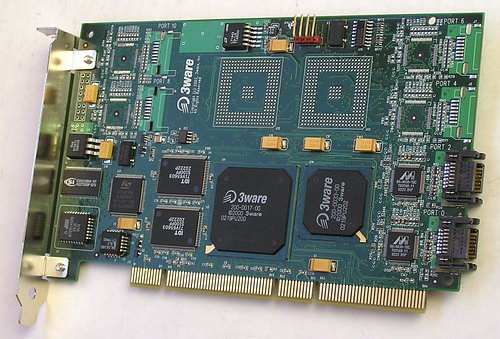 the 3ware Escalade 8500-4 SATA RAID controller for PCI64 bus.
and a popular budget 4-port Silicon Image SiI3114 (reference card) for PCI32 bus (33 or 66 MHz). The latter takes part in this review connected in two different ways — to PCI-X bus and to PCI32/33 MHz (in the latter case RAID performance may be limited due to insufficient bandwidth of the "consumer" PCI bus). Remember that the AAR-2410SA and Esclalde 8500-4 are approximately in the same class (both are professional RAID controllers supporting RAID 5, on-board cache, and lots of services), while the SiI3114 supports only RAID 0, 1, and 10 and has no cache. All the more interesting it will be to determine which model is the fastest in RAID 10 (easy to calculate). Tests were carried out with four Western Digital Caviar RAID Edition WD1200SD drives, 120 GB each. In case of AAR-2410SA and Escalade 8500-4 controllers, the default striping block size for RAID 10 was 256 KB, write cache enabled. The SiI3114 also used the default settings, BIOS 5.0.44 and Drivers 1.0.0.7. BIOS and driver versions for the Adaptec controller — 7.3.4.8, for the 3ware controller — BIOS 7.7.1 and Driver 1.15.00.014. We used the following testbed configuration to test storage drives:
The tests were carried out under MS Windows XP Professional SP2. The RAIDs were tested not partitioned (in Intel Iometer 2003.5.10, H2Benchw 3.6 and AIDA5 tests) as well as partitioned and formatted by regular operating system tools depending on a test type: one NTFS partition of maximum size for testing the average access time and plotting the read rate graph in WinBench 99 and two NTFS or FAT32 partitions of the same size for other tests (WinBench Disk WinMark 99 2.0, ATTO Disk Benchmark test, multithreaded read/write, and the Adobe Photoshop CS test). Each NTFS partition occupied half of the entire disk capacity (that is the second partition started exactly from the second half of the disk). FAT32 partitions were 32768MB, the first one starting at the outer edge of the media (on the "fastest" tracks), and the second — exactly from the middle of the media volume. NTFS and FAT32 cluster sizes were selected by default — 4 and 16 KB correspondingly. It should be mentioned that our attempts to test Adaptec and 3ware controllers connected to the PCI-X bus in this system failed — there were some glitches. As a result, we used the jumper to set the motherboard to PCI64 mode.
Results of the physical parameter testsLinear reading rate graphs for RAID 10 on various controllers are the first to go (click icons to see full-sized graphs).
Linear reading rate graphs for RAID 1+0 (four WD1200SD drives) on the 3ware Escalade 8500 and Silicon Image SiI3114 controllers nearly equal the twofold (in both axes) graph for a single WD1200SD drive. In this case, the SiI3114 on "slow" PCI bus shows no signs of RAID performance limitation due to the insufficiently high PCI bandwidth (compare the PCI32 and PCI64 graphs). But this RAID performance on Adaptec 2410SA is limited at the level of 97 MB/s, that is it lacks nearly 17% at the beginning of the disk and about 10% in the average (across the entire volume) performance. Besides, the "prancing" (even on the inner tracks) graph for the AAR-2410SA is not optimistic. Let's proceed to interface transfer rates. But there are surprises even here. Only Sandra 2005 managed to evaluate the interface transfer rates of all controllers more or less adequately. The majority of other utilities for Adaptec and 3ware controllers acted strangely — the effect of cache in these controllers. Interestingly, in case of the SiI3114 on PCI-X bus (on controller's side — 32 bit 66 MHz, that is 266 MB/s maximum) this very Sandra 2005 showed the Serial ATA 1.0 transfer rate at the level of 180 MB/s, that is evidently higher than the interface maximum (150 MB/s). As the SiI3114 has insufficient cache memory, we can only assume that this transfer rate is a total of reading rates from buffers of two "parallel" hard drives in the array. There are no surprises in the average access times. But in case of the AAR-2410SA, this time has grown by nearly 1 ms (Is it due to the controller's cache access latencies?) But then, the Adaptec controller obviously demonstrates the best results compared to the other contenders. However, this can be seen only in H2Bench. The average write access time for our model under review shown by IOmeter test is on the contrary worse than in other contenders. We can draw only one conclusion from this result — a powerful caching host controller with on-board memory allows to noticeably reduce the differences between RAID hard drives. Caching host controllers with on-board memory may provide noticeable performance gain for storage drives and RAIDs in those applications, which often write at random and pseudo-random addresses. But on the other hand, they may lead to some performance losses (compared to non-caching hosts) in tasks with multiple random reading operations.
Performance in applicationsLet's have a look how the hard drives fair in old but still popular Disk WinMark 99 tests from the WinBench 99 package. We carry out these tests not only for the beginning but also for the middle part (in terms of capacity) of physical hard drives for two file systems. The diagrams display average results. Interestingly, both controllers with on-board cache fall catastrophically behind the simplest SiI3114 under office as well as professional loads! The SiI3114 probably has a powerful Windows caching driver (heavily optimized for WinBench 99), which provides such high results in this test. In a newer PCMakr04 track test the gap between the controllers is not that large, though Adaptec 2410SA is outperformed by its competitors, while the SiI3114 demonstrates a large gain from using a higher-frequency PCI bus. The AAR-2410SA is doing much worse in another complex track test — H2Bench. It's twice as slow here than the 3ware 8500-4. But the SiI3114 on the fast PCI bus looks almost like a leader, noticeably outperforming its own results on the desktop PCI bus. The SiI3114 on professional PCI bus also leads in the real RAID 10 performance test (Adobe Photoshop CS swapping performance), while caching controllers are noticeably slower here.
Intel IOmeter testsLet's proceed to tasks, which are more typical of the professional SATA RAID profile — DataBase, File Server, Web Server and Workstation patterns in Intel IOmeter 2003.5.10. There is almost no difference between the SiI3114 on various PCI buses in serious patterns. Instead, the Adaptec AAR-2410SA overruns its competitors with high queue depths, while the 3ware controller can hardly boast even before the SiI3114. Good performance scalability of the Adaptec controller with the increase of command queue is also good news. According to the geometric average of the above server loads, the Adaptec2410SA controller with RAID 10 outperformed the other contenders by more than 25%! An excellent result. A tad lower results are demonstrated in the workstation pattern, though Adaptec still retains its leadership. But our hero is an obvious outsider in random reading and writing of large files. The caching controller from 3ware has a small advantage here. However, Adaptec recoups itself in random reading and especially writing of small files with the large queue depth. The SiI3114 controller is indifferent to PCI bandwidth selection here, like in case of large files. The Adaptec controller shows superiority in copying files, especially with high QD. This advantage may reach two-fold, but on the average the AAR-2410SA is faster than the others (approximately equal) in random copying by 40%! Nevertheless, according to the averaged results of reading, writing, and copying files (with single weight), the Adaptec controller is a tad slower than its competitors, while the SiI3114 is nearly as fast as the 3ware Escalade 8500-4. The defragmentation test again shows evident leadership of the 3ware controller, while the Adaptec model is outperformed even by the SiI3114. And finally, all controllers are generally on a par in the streaming read/write pattern with large and small blocks, though the SiI3114 is a tad faster than the others with large blocks at a large queue, while the Adaptec — with small blocks.
ConclusionWe can only welcome the appearance of such a product as Adaptec Serial ATA RAID 2410SA Enclosure Kit - an accomplished and streamlined solution for professional 4-drive SATA RAIDs with a warranty from one and the same manufacturer. Now users don't have to choose a "controller-enclosure" pair and carry out compatibility tests. Additional features, like the controller supporting some functions of the enclosure, only amplify the attractiveness of this tandem. There are some disadvantages, of course: for example, our sample of the 2410SA controller was not very stable, its linear reading graph for RAID 10 was evidently below what it should have been. Its RAID 10 performance in typical desktop tasks was not always on a par with the competitors. At the same time, the AAR-2410SA has very strong performance points — server and workstation patterns, copying files (especially with a large queue depth). That's another proof for its purely professional profile, while cheaper solutions (SiI3114 and the like) are often more expedient for consumer and desktop tasks. Adaptec Serial ATA RAID 2410SA Enclosure Kit was kindly provided by the official Adaptec distributor in Russia — MD Group.
Write a comment below. No registration needed!
|
Platform · Video · Multimedia · Mobile · Other || About us & Privacy policy · Twitter · Facebook Copyright © Byrds Research & Publishing, Ltd., 1997–2011. All rights reserved. |